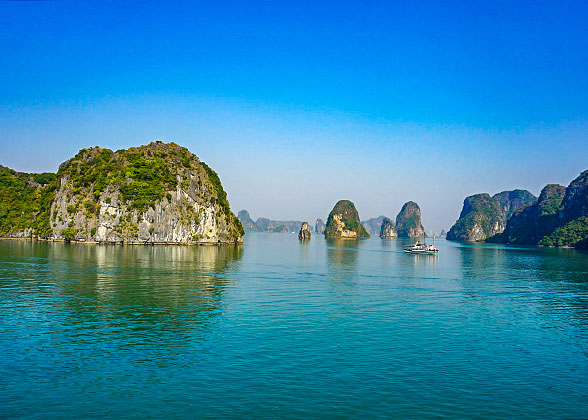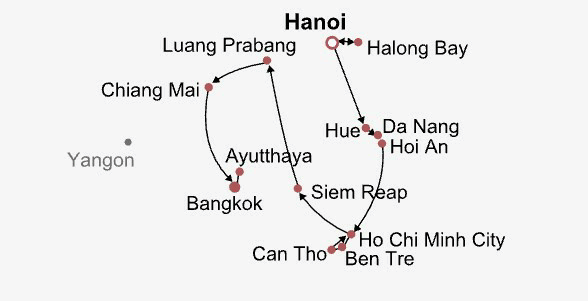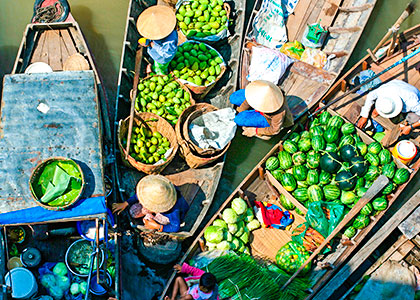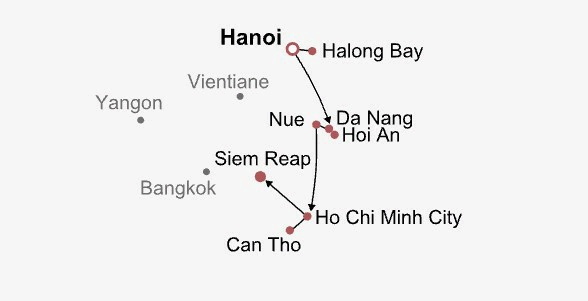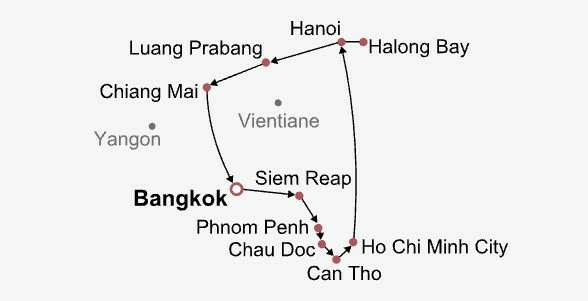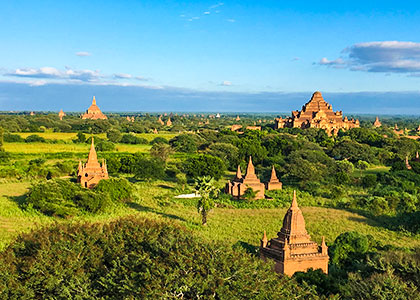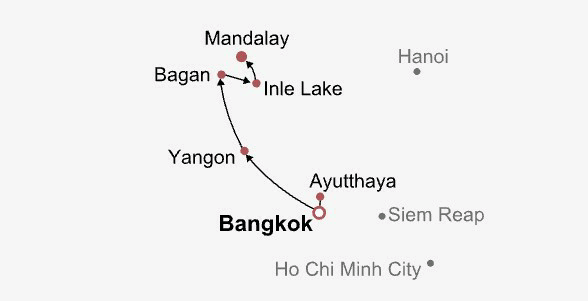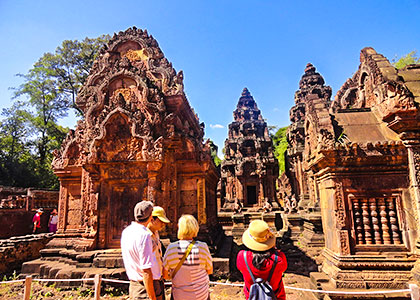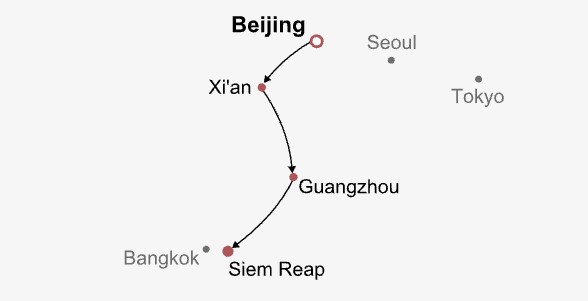A Brief Introduction of Indochina
Indochina refers to countries heavily influenced by India and China, including Thailand, Vietnam, Cambodia, Laos and Myanmar. These five counties are closely connected geographically and culturally, sharing natural resources like the Mekong River and the religious faith, Buddhism. But each country also boasts its own special and attractive historical relics and stunning natural beauties, which will bring you different experiences and feelings.
When is the best time to visit Indochina?
Overall, most areas in Indochina are dominated by a tropical monsoon climate, with dry and rainy seasons. And the best time for Indochina tours is from November to next March, when there is plenty of sunshine and the temperature is moderate, suitable for outdoor activities and sightseeing.
The rainy season falls between April and October, with abundant rainfall and high temperatures and humidity. Bring breathable clothing, sun protection gear and insect repellent, and drink enough water to stay hydrated.
Furthermore, it should be noted that northern Vietnam has a subtropical monsoon climate with distinct four seasons, and it’s especially cold in winter (Dec.-Feb.) in Sapa, with the temperature sometimes dropping below 0°C, so pack a windproof coat or a thin down jacket if you plan to visit then.

Ha Long Bay, Vietnam

Bayon Temple, Cambodia
What are the highlights of each country in Indochina?
Thailand: More than 90% of the Thai people believe in Buddhism, making its capital Bangkok deemed the "Buddhist capital". Pagodas, monasteries and Buddhist statues can be found everywhere, which is a highlight of Thailand.
In addition, when we talk about Thailand, beaches, sea and islands pop into our heads. Therefore, the leisure time at the seaside, like the Phuket Island, is another highlight. Sunbathing on the beach and exploring the colorful aquatic creatures under the crystal-clear water will surely help you escape the hustle and bustle of the city!
What’s more, Thailand boasts many vibrant festivals, such as April’s Songkran Festival, aka the Water Splashing Festival. At that time, tourist cities like Bangkok, Chiang Mai, Phuket and Ayutthaya would held grand activities and allow tourists mingle with the locals! People dressed in bright shirts and wielding colorful water guns constantly spray water at others around. In some places, even elephants would join the “battle”!
Vietnam: Ha Long Bay, famous for its over 3,000 limestone karst mountains and islands, is listed among the world's new seven wonders of nature, and one of Vietnam’s highlights. The most popular way to tour Ha Long Bay is to take a sightseeing cruise with one night stay onboard. During the whole journey, you’ll not only enjoy the picturesque scenery onboard, but disembark to visit karst caves, islands and villages.
What's more, the Cai Rang Floating Market on the Mekong River is another highlight of Vietnam. The hard-working people, coming and going boats, constant sounds of bargaining will show you the realest picture of the local market. On many boats stands a long bamboo pole, hung with a variety of products, which is the boatman's "billboard". You can tell from it what the boatman sells!
Cambodia: Angkor Complex, which refers to the temple ruins, palaces and other structures of the ancient Khmer Empire (802-1431), is the highlight of Cambodia. The following are some representative ones.
Angkor Wat, the largest surviving Hindu-Buddhist temple in the world, is rated one of the three wonders of the Southeast Asia. Famous for its magnificent architecture and exquisite reliefs, it is the peak of Khmer classical architectural art. As a national symbol of the country, it’s even featured on the Cambodian flag. Besides, the sunrise here provides a marvelous visual treat, known as one of the world’s most beautiful sunrise wonders, which should not be missed.
Bayon Temple, the quintessence of Angkor Thom, was built in the late 12th century. It is a symbol of Khmer's religious transition from Hinduism to Buddhism, and the ubiquitous serene "Khmer Smile", 216 massive smiling faces carved on 54 towering stones, hints at the Buddha’s compassion and sublimity. In addition, the vivid bas-reliefs depicting daily life, religious rituals and customs also provide an in-depth understanding of Angkor.
Ta Prohm Temple is one of the largest and most artistic monuments in Angkor. What makes it unique is the surrounded huge trees, which are intertwined tightly with the temple ruins. The movie Tomb Raider was filmed here, adding to the mystery of this place.
Banteay Srei Temple is famous for its brilliant red hue and exquisite reliefs, making it noted as the “Jewel of the Khmer Art”. You can see the reliefs on almost all its walls and pillars, among which the graceful postures of the fairy Apsara are particularly attractive.
In addition, the floating villages on the Tonle Sap Lake are also worth a visit. One of them is home to thousands of Vietnamese, many of whom fled the Vietnam War. Without registered residence, they can only live in stilt houses on the water and live by fishing. If lucky, you could see the children sitting in a basin, frolicking innocently.
Laos: Luang Prabang is Laos' Buddhist center. The most distinctive local culture must be the morning alms-giving ceremony, which is a vital part of many Laotians’ daily life. Every morning at around 5:30, the devotees would sit or kneel along the streets with prepared food, waiting for the monks. The monks holding their bowls pass barefoot in front of every devotee orderly and receive the offerings. After receiving food, the monks will sometimes recite a sutra in return, thanking the devotees for their kindness. You can purchase some food from the vendors around to experience the ritual.
Myanmar: The Shwedagon Pagoda in Yangon, built in 585 BC, is known as one of the three wonders of Southeast Asia, together with Angkor Wat in Cambodia and Borobudur Temple in Indonesia. With its splendid architecture and sacred legends, it is Myanmar's Buddhist shrine as well as a national symbol.
Bagan is one of the three major Buddhist sites in Asia, once with more than four million pagodas and monasteries! The pagodas here are of various shapes, like square, round and polygon, and of rich colors such as khaki, reddish-brown, pure white and gold. These diverse pagodas carry more than 1,000 years of Bagan history.
The Mahagandayon Monastery in Mandalay is the largest one in Myanmar, which is like a monk's university, with more than 1,000 students. Every day at 10:00, visitors from all over the world come here to see the grand scene of thousands of monks lining up for lunch from local devotees.
U Bein Bridge, with a length of almost 1,200 meters (3,937 feet), is a landmark of Myanmar. Made entirely of teak, one of the world’s most precious trees with good anticorrosion and mothproof effect, the wooden bridge has existed for over 170 years! The sunset over U Bein Bridge is so stunning that many lovers like to come here to enjoy the beauty and romance, earning the bridge the fame of "Love Bridge".

